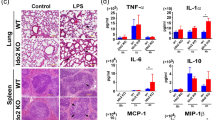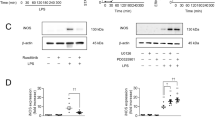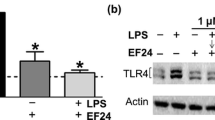Abstract
Monocytes become activated at sites of inflammation and contribute to the pathology of many diseases, including septic shock. In these cells, induction of genes expressing various inflammatory mediators, such as cytokines, chemokines, and growth factors, is regulated by nuclear factor-κB (NF-κB)/Rel transcription factors. Recent studies have identified components of the signal transduction pathways leading to the activation of NF-κB/Rel proteins. Inhibition of these signaling pathways provides a novel therapeutic approach to prevent inducible gene expression in monocytes.
Similar content being viewed by others
References
Müller JM, Ziegler-Heitbrock HWL, Baeuerle PA: Nuclear factor kappa B, a mediator of lipopolysacharide effects. Immunobiology 1993;187:233–256.
Verma IM, Stevenson JK, Schwarz EM, Van Antwerp D, Miyamoto S: Rel/NF-ϰB/1ϰB family: intimate tales of asociation and dissociation. Genes Dev 1995;9:2723–2735.
Wulczyn FG, Krappmann D, Scheidereit C: The NF-ϰB/Re1 and 1ϰB gene families: mediators of immune response and inflammation. J Mol Med 1996;74:749–769.
Read MA, Whitley MZ, Williams AJ, Collins T: NF-kappa B and 1kappaB α: an inducible regulatory system in endothelial activation. J Exp Med 1994;179:503–512.
Parry GCN, Mackman N: A set of inducible genes expressed by activated human monocytic and endothelial cells contain ϰB-like sites that specifically bind c-Relp65 heterodimers. J Biol Chem 1994;269:20,823–20,825.
Baeuerle PA, Baltimore D: NF-ϰB: Ten years after. Cell 1996;87:13–20.
Whiteside ST, Epinat J-C, Rice NR, Israël A: 1 kappa B epsilon, a novel member of the 1 kappa B family, controls R elA and Rel NF-kappaB activity. EMBO J 1997;16:1413–1426.
Thompson JE, Phillips RJ, Erdjumen-Bromage H, Tempst P, Ghosh S: 1ϰB-β regulates the persistent resporse in a biphasic activation of NF-ϰB. Cell 1995;80:573–582.
Chen ZJ, Hagler J, Palombella VJ, Melandri F, Scherer D, Baliand D: Signal-induced site-specific phosphorylation targets 1ϰBα to the ubiquitin-prote osome pathway. Genes Dev 1995;9:1586–1597.
Chen ZJ, Parent I, Maniatis T: Site-specific phosphorylation of 1ϰB α by a novel ubiquitination-dependent protein kinase activity. Cell 1996;84:853–862.
Didonato JA, Hayakawa M, Rothwarf DM, Zandi E, Narin M: A cytokine-responsive 1ϰB kinases that activates the transcription factor NF-ϰB. Nature 1997;388:548–554.
Mercurio F, Zhu H, Murray BW, Shevchenko A, Bennett BL, Li JW, Young DB, Barbosa M, Manning AM, Bao A. 1KK-1 and 1KK-2: cytokine-activated 1ϰB kinases essential for NF-ϰB activation. Science 1997;278:860–866.
Régnier CH, Song HY, Gao X, Goeddel DV, Cao Z, Rothe M: Identification and characterization of an 1ϰB kinase. Cell 1997;90:373–383.
Woronicz JD, Gao X, Cao Z, Rothe M, Goeddel DV: 1ϰB kinase-β: NF-ϰB activation and complex formation with 1ϰB kinase-α and NIK. Science 1997;278:866–869.
Zandi E, Rothwarf DM, Delbase M, Hayakawa M, Karin M: The 1ϰB kinase complex (1KK) contains two kinase subunits, 1KK α and 1KKβ, necessary for 1ϰB phosphorylation and NF-ϰB activation. Cell 1997;91:243–252.
Weih F, Carrasco D, Durham S, Barton D, Rizzo C, Ryseck R, Lira S, Bravo R: Multiorgan inflammation and hematopietic abnormalities in mice with a targeted disruption of Re1B, a member of the NF-kappaB/Rel family. Cell 1995;80:331–340.
Xia Y, Pauza ME, Feng L, Lo D: RelB regulation of chemokine expression modulates local inflammation. Am J Pathol 1997;151:375–387.
Xia Y, Chen S, Wang Y, Mackman N, Ku G, Lo D, Feng L: RelB modulation of 1kappaB alpha stability as a mechanism of transcriptional suppression of interleukin-1alpha (IK-1alpha), IL-1beta, and tumor recrosis factor alpha in fibroblasts. Mol Cell Biol 1999;19:7688–7696.
Schreck R, Meier B, Männel DN, Dröge W, Baeuerle PA: Dithiocarbamates as potent inhibitors of nuclear factor ϰB activation in intact cells. J Exp Med 1992;175:1181–1194.
Ziegler-Heitbrock HWL, Sternsdorf T, Liese J, Belohradsky B, Weber C, Wedel A, Schreck B, Baeuerle P, Ströbel M. Pymolidine-dithiocarbamate inhibits NF-ϰB mobilization and TNF production in human monocytes. J Immunol 1993;151:6986–6993.
Kopp E, Ghosh S: Inhibition of NF-ϰB by sodium salicylate and aspirin. Science 1994;265:956–959.
Oeth P, Mackman N: Salicylates inhibit lipopolysaccharide induced transcriptional activation of the human tissue factor gene in monocytic cells. Blood 1995;86:4144–4152.
Ridker PM, Cushman M, Stampfer MJ, Tracy RP, Hennekens CH: Inflammation, aspirin, and the risk of cardiovascular disease in apparently healthy men. NEJM 1997; 336:973–979.
Mackman N: Protease inhibitors block lipopolysaccharide induction of tissue factor gene expression in human monocytic cells by preventing activation of c-Rel/p65 heterodimers. J Biol Chem 1994;269:26,363–26,367.
Ollivier V, Parry GCN, Cobb RR, de Prost D, Mackman N: Elevated cyclic AMP inhibits NF-ϰB-mediated transcription in human monocytic cells and endothelial cells. J Biol Chem 1996;271:20,828–20,835.
Parry GCN, Mackman N: Role of cyclic AMP response element-binding protein in cyclic AMP inhibition of NF-ϰB-mediated transcription. J Immunol 1997; 159:5450–5456.
Gerritsen ME, Williams AJ, Neish AS, Moore S, Shi Y, Collins T: CREB-binding protein/p300 are transcriptional coactivators of
Author information
Authors and Affiliations
Rights and permissions
About this article
Cite this article
Mackman, N. Lipopolysacharide induction of gene expression in human monocytic cells. Immunol Res 21, 247–251 (2000). https://doi.org/10.1385/IR:21:2-3:247
Issue Date:
DOI: https://doi.org/10.1385/IR:21:2-3:247




